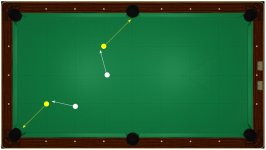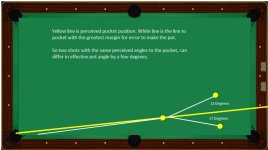I finally get what you're saying - and my diagram above doesn't show it, but it agrees with the shooting-away-from-the-rail definition of back cuts.I realized after I posted that my explanation would not apply to everyone because they dont focus on one quadrant like I do.
When I aim I focus on only one quadrant. A back cut has me focusing on the far side quadrant... the quadrant that doesnt allow me to view the whole quadrant from behind the cueball.
For an example I'll use your diagram. I'm dividing the ball into four quadrants from an overhead view. The ball is divided in half parallel to the side rails and again in half parallel to the end rails... making four quadrants.
Ball 2 can only be made in the target pocket by hitting the ball, in one of the quadrants. In this case the quadrant, looking at it from a top view like in the picture, would be the bottom right. No matter where it is on the table, if you want to pocket the ball in that target pocket you must make contact with the object ball within that quadrant (unless you bank it). So that is the quadrant I focus on for that pocket.
Ball 1 would need a top right quadrant for the chosen pocket.
A backcut does never allows me to see the whole quadrant I need while a regular cut gives me a view of the full quadrant I need.
I hope that makes sense.
Another way of describing your back cut is whenever the CB crosses an OB's quadrant line before hitting it. Because the quadrant lines are oriented to the table, this can only occur when you're shooting away from the rail. Interesting way to look at it.
pj
chgo
Last edited:

